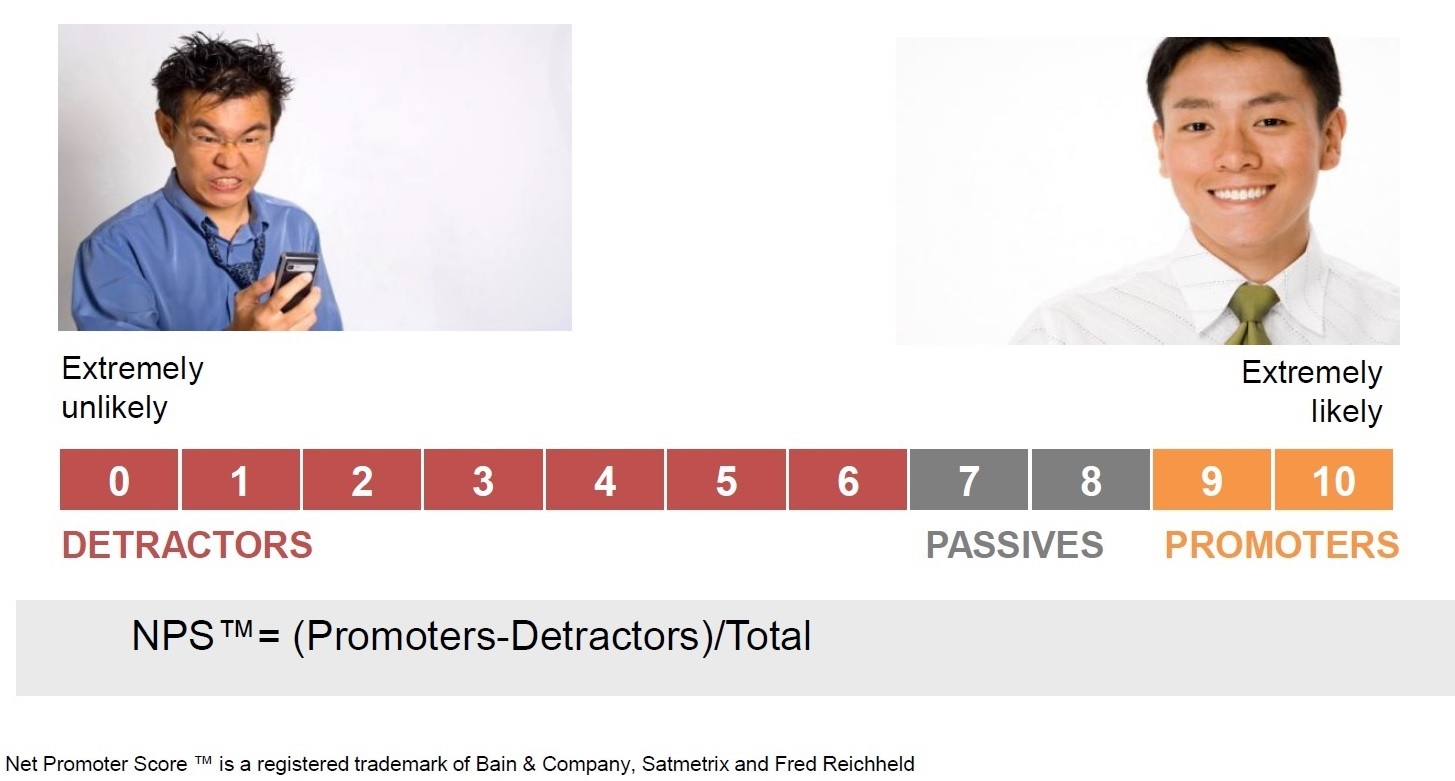FAQ
If you want to make your company more profitable and not only to win new clients, but to convert them to your truly defenders - take a look at the answers below. Learn more about Voice of the Customer, NPS and how you can use those methods to achieve your goals!
NPS and Voice of the Customer
1. What is Net Promoter Score (NPS)?
Net Promoter Score® (or NPS in short) is a measurement of customer happiness and loyalty, expressed in recommendation. NPS is based on the fundamental idea that customers, who have been treated well by a company, are likely to recommend the products or services of that company to their peers, creating extra sources of revenue for the company. Consecutively, customers who have been unhappy with products or services are likely not only to stop buying the said product or service but also create negative word of mouth, stopping their peers from becoming customers.
By asking: “How likely is it that you would recommend [your company] to a friend or colleague?” you can measure your company’s performance through your customers’ eyes. Customers respond on a 0 to 10 rating scale and are categorized as Promoters (9 and 10), Passives (7 and 8) or Detractors (6 to 0) depending on their answer:
- Promoters: The happiest customers who are ready to share their positive experience with your company with their friends and families, and keep buying from you.
- Passives: Satisfied but not very moved customers who may still refer positively to you, but may also reflect on some downsides of your relationship. These customers are likelier to switch to competitors should the opportunity arise.
- Detractors: Disappointed and unhappy, these customers will create negative word of mouth and will cease their relationship with you the moment they have a chance.
After this data is gathered and simple calculation is made: Promoters – Detractors = Net Promoter Score.
2. What is Customer-Centricity?
Customer-centricity is a business philosophy based on the idea that customers are the most important element of any business, and should therefore be treated as such. The two basic principles of the philosophy are:
- understanding your customers’ needs
- re-organising your business so that it can deliver it
While simple on a high-level, the customer-centric business approach turns out to be difficult at that point when you need to deliver your business promises in a profitable and sustainable manner. So the challenge we at Futurelab Research can help you with is proving that your business can be customer-centric AND profitable.
3. Can NPS make my business more profitable?
Yes! The core proposition of Net Promoter System is based on the fact that Promoters are more profitable than Passives and Detractors. A simple business case can always be made for any product or service:
Let’s assume that Promoters have a lifetime value of 100 euros, and stay with your company for 5 years. This will bring you 500 euros in direct value per person. But Promoters also usually recommend you, and through their lifetime with your company may bring a few more customers. If a Promoter brings at least one more customer per year with an average value of 75 euros per year, then the value created by their recommendation will equal to 375 euros per person per year. So in total a Promoter would have a value of 500 + 375 = 875 euros in a lifetime.
As opposed to them, Detractors will have a lower value – say, 50 euros, and will only stay for 2 years. Then the direct value of a Detractor would amount to only 100 euros. But as they would also speak negatively about your company, Detractors would actually create loss. If a Detractor stops at least one person a year from becoming your customer (with same average value of 75 euros per year), it would mean a loss of 150 euros. So with a Detractor, you end up with loss: 100 – 150 = -50 euros!
And as NPS identifies key problematic elements of customer experience in your company, you can make your business more profitable by growing the number of Promoters, moving Passives into becoming Promoters, or reducing the number of Detractors.
4. Why should I be using NPS instead of my regular customer satisfaction research?
There is nothing wrong with your regular CSat. The difference that NPS makes lies in the applications of the research rather than in the numbers themselves. NPS concentrates on an outcome of customer happiness – a positive action of recommending something this customer enjoyed, rather than on measuring the level of happiness itself. This ‘positive outcome’ basis allows NPS to provide more correct predictions of the future company’s growth than a regular CSat (see also Reichheld’s publication “The One Number You Need to Grow” – Harvard Business Review). In the end of the day, customers pay to be satisfied, but making someone recommend, i.e. add value to your business – that’s what NPS is about.
Methodology / How
1. What are the best channels for measuring NPS?
You can measure NPS via all channels available to a modern researcher: face-to-face, by e-mail invitation (to an online questionnaire), by sms, by phone, by mobile phone, in a pop-up window on your website, via apps, in places of purchase (for example, by placing a tablet with an open survey next to the shop exit). Do take notice though that the results will likely differ depending on the channel of measurement. We at Futurelab Research like online questionnaires – they are quick and easy, they create no respondent-interviewer bias, and you see the results instantly. However the actual choice of channel will depend both on your business type and the objectives of the research.
Let us know a few things about yourself – and we’ll find out the best way to capture your customers’ voice.
2. What data do I need to measure NPS correctly?
You can start an NPS survey with virtually no data at all – by using, for example, one of the existing customer panels (of course this will only work if your company’s products or services are relatively well known). But of course, the more you know about your customers, the better you can adjust the NPS measurement: look into different demographics, segments, regions, etc. So to get good results we would normally look first at your own customer contact database. Then we can reach out to them – and be sure that this is the voice of YOUR customers. We would also make sure that the database is clean, contains no error entries, and is free of duplications and spam mail.
Let us know a few things about yourself – and we’ll find out the best way to capture your customers’ voice.
3. I don’t have any information about my customers. Can I still measure NPS?
Sure! We already know the most important thing about your customers – that they are using your product. Let’s look how we can reach out to them. It can be an easily accessible online panel (if your product is relatively well-known); a tablet or an interviewer in the places where your products are sold; or even a letter (as in “a piece of paper with a questionnaire typed on it”). Yes, they still exist, and oh yes, they work just as fine.
Let us know a few things about yourself – and we’ll find out the best way to capture your customers’ voice.
4. How many customers should I survey?
You are probably tired of hearing it, but it really depends on what your company does, how, and where. But we can provide you with some guidelines:
First of all, you need to know how large your potential customer base is. Is it a whole country of several million people, or a limited number of business operatives taking decisions? The first example will require a considerably larger sample size, while in the second case there might not even be an actual need to choose. You may want to just go on and ask every single one of them.
Then you need to think about the level of precision you need. Do you need just a broad understanding of what the situation is, and whether you are in tens, zeros or even minus tens? Or is the game about the smallest percentage points’ difference between you and your competitors? Precision is a serious factor for calculating sample sizes.
These two parameters will define the number of people in your sample. Please use our widgets to define the number of customers you would want to survey. Keep in mind though that if you want the same precision for the sub-divisions of your customer base (e.g. if you want to look at men and women separately, or understand the differences between regions, or you have a relevant good segmentation that you want to take into account), you would need a valid sample size per segment.
5. Will you provide me with recommendations on how to improve?
The full methodology of NPS implies asking 3 questions:
-
Would you recommend us?
-
Why did you give that score?
-
What should we do to improve?
The last 2 questions are open-ended, meaning that the respondents can leave comments and improvement suggestions – as long as they like, in the form they like. The answers to the “Why” question give you an idea of what you are doing right – or wrong; what makes your customers tick – or cringe. The answers to the “Improve” question tell you what things you really have to make better in order to get a higher score.
So in fact your customers will tell you what to do to become better. What we will do with their feedback is: sorting their answers into several easy to understand categories; create a prioritized action list on the basis of what your customers say; and finally, look at best practices in your industry to pave the road ahead of you. We have a number of carefully educated and properly certified NPS consultants for that.
6. Can we do B2B NPS? Is there any difference between B2B and B2C NPS?
Yes! NPS can be used in a B2B environment. However it has to be approached in a slightly different way in order to maximize results and efficiency. In a B2B your relationship touches different types of people: there are users, choosers and influencers. E.g. for a firm selling sophisticated electronic equipment a request for answering a couple of questions will be sent to both the engineer using the equipment (user), the senior management purchasing the equipment (chooser), and a procurement manager that runs the RFP process (influencer). All parties will have different needs and questions which have to be met and answered. So we will advise to measure the NPS of these people separately. And this is only a start – a good B2B program requires very careful planning.
Let us know a few things about yourself – and we’ll find out the best way to capture your customers’ voice.
Our products
1. I want to measure NPS of my customers. How do I start?
The quickest and easiest way to start is NPSStart – a product designed for giving a “tasting” of what NPS can do. 500 responses, quick results, top-line analysis and recommendations for quick wins and long-term improvements.
If, however, you want something more than just a tasting, have a look at NPSScope or even NPSStrategy. With these products you will get more responses, deeper levels of analysis (both qualitative and quantitative), and with Strategy – an action-inspiring workshop with your stakeholders on top of the survey results. For serious, check NPSScope, for tailor-made solution – look at NPSStrategy.
2. How much does NPS research cost?
Depends a bit on your product and industry. The lightest and fastest product we have, NPSStart is priced at 12,000 EUR. The price for NPSScope starts from 17,500 EUR; and for NPSStrategy – from 25,000 EUR.
Let us know a few things about yourself – and we’ll find the product for you for the best price.
3. We use NPS, but I don’t think it is working for us. How can we fix this?
Good that you ask! We have several clients who had the same issue: they started with NPS, but in the beginning things did not work out so well for them. Sometimes, the numbers won’t add up; other times it is the people who do not understand the concept; or the management won’t walk the talk. To help these issues, we have developed 2 products:
- NPSActivate is a 1-day “activating” workshop, created for the single purpose of switching the power of NPS fully on in your company. Questions will be answered. Doubters will be convinced.
- NPSCalibrate is a 10-day scan conducted with the purpose of understanding whether your NPS program has a weak spot; something that does not work quite well yet. We check your program against a rigorous list of standards across 5 main areas, talk to your stakeholders and compile the results into understandable, actionable chunks of information. If something can work better in your program, Calibrate will find it out.
4. How much time would Futurelab need to get our NPS research done?
The preparation takes a couple of weeks, during which we will look into your company’s existing research (market information, segmentation, etc.) as well as strategy; select the best data collection channel, and make sure everyone in the team is aligned around the project. The actual surveying takes from 10 days to 2 months, depending on the data collection channel (some channels are faster than other ones).
We tend to say that we are as fast as you are. If you can provide us with a clean, ready-to-dispatch contact database for your customers, and your team is fully aligned on the project, we can make the whole thing happen within 4-6 weeks. But as good quality customer databases occur rarely, and fully aligned companies are even rarer, we would recommend looking at a 3 month timeline as optimal.
5. In which countries do you offer your services?
We provide our services throughout Europe (and sometimes in the US as well). Our main business language is English, but we are fairly multi-lingual – the core team alone speaks English, Dutch, German, Russian, French, Spanish, Czech, Danish, and a few other languages. All surveys can be localised, too.
6. Which industries can you survey?
There is no limit to industries for us. Our expertise covers a vast variety of both B2B and B2C products and services: engineering, software, pharma, FMCG, food and beverages, biotech, governmental agencies… But we can really go all out in finance, automotive, retail, lifestyle, and telecom.
Let us know a few things about yourself – and we’ll send you the list of our credentials for your industry.
Our company
1. How long have you been doing this?
LONG. Futurelab is one of the Europe’s first ever customer-centricity consultancies existing since 2003, and since the very first days we have been dealing with NPS measurement and its outcomes. Initially we only did consultancy, but in 2012 the research branch appeared as our own NPS surveying facility. Have a look at what else we do.
2. How can I contact you?
Via any channel you want.
Give us a call: +32 2 733 8332
Send us an e-mail: research@futurelab.net
A letter would be awfully nice: Uitbreidingstraat 84, Antwerpen 2600, Belgium
Hey, why don’t we meet for coffee?
Let us know how to contact you and one of us will be happy to meet and answer your questions.
3. Do you offer trainings for the employees of your clients?
We do. Trainings can come in different forms and shapes. We can do a 1- or 2-day NPS workshop / seminar (have a look at NPSActivate). We can also work out a whole training program, which would include teaching your team on the basics of NPS, how to close the loop, what to do so that Promoters really promote, etc. Give us a buzz and we will offer you a couple of nice options.
4. Are you hiring?
Sometimes. We are always interested in people who have experience in NPS, whether on the measurement or consultancy side. Send your CV here if you think you are just the right one for us.
5. What information do you need from me?
We do not need anything from your company as such, as we always run a desk-research prior to any project. However, if you choose to select the full package and would like us to look deeper into particular customer segments or about geography, we will need information about these factors from you. Any additional info about your market, customer peculiarities, company details and other useful information would only make the results better.
6. What is your approach with dealing with data privacy issues?
To abide with the latest European data privacy regulations, we store the data gathered in the course of our surveys only on European servers. For overseas customers, we are ready to provide a local solution via one of our SAAS platform colleagues.








